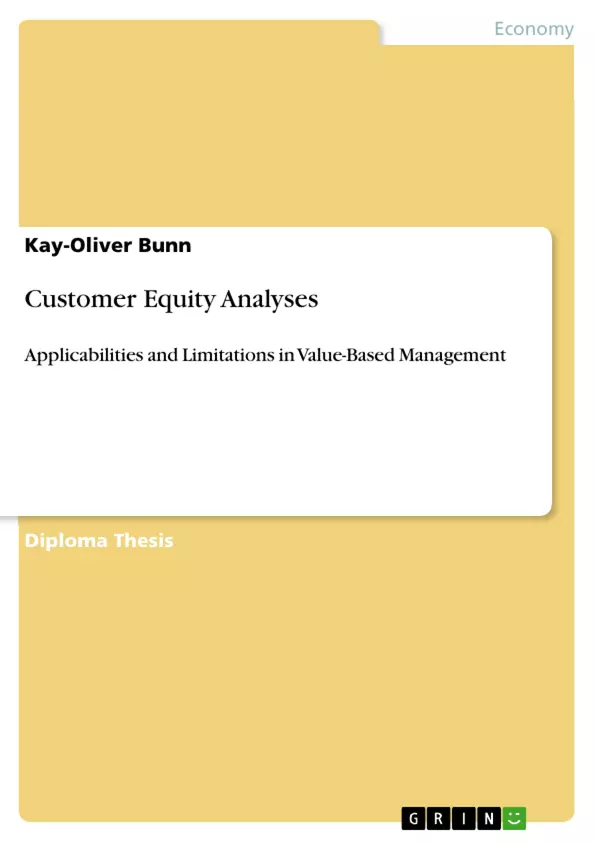Corporate management today is exposed to an area of conflict that allows only limited latitude. On the one hand, top management is regularly faced with the company owners’ requests for an appropriate return on equity or Shareholder Value, a request that executives of public companies are mostly obliged to by contract: “Corporate Mission Statements proclaiming the responsibility of management is to maximize shareholder’s total return via dividends and increases in the market price of the company’s shares around.”
On the other hand, increasingly mature and well informed customers demand more and more customized goods for their individual requirements and are often known to change their buying behavior quickly. This behavior forces many organizations to an uncompromising orientation towards Customer Value, and a strict customer focus in both corporate planning and management, in order to further develop competitive advantages and to satisfy and retain valuable customers. This is particularly true for middle and lower management.
Hence value creation for customers finds itself opposed to value creation for shareholders. A conflict that appears to find its resolution only in a consequent consideration of customer relationships as investment objects, whose continuation or intensification must be justified through an evaluation of economic efficiency. Against this background, systematic customer valuations become indispensable in order to obtain segmented and efficient market development and to enable a supplier to substantially ensure the availability of the critical resource customers.
Based on the fundamentals of value-based management theory, value-based marketing and the reciprocal character of customer orientation, the author examines the coherence between Customer Equity and Shareholder Value and discusses how and to what extent it can become an appropriate management performance indicator for value-oriented customer relationship management. Furthermore, a selection of some of the most important monetary and non-monetary value potentials of customer relationships are characterized and interpreted.
The author concludes with a critical discussion of the applicabilities and limitations of a wide array of uni-dimensional, multi-dimensional and process-oriented Customer Equity models that are suggested to give marketers and managers a better understanding of the fundamental question for the contributions of marketing to organizational performance.
Table of Contents
- 1. Introduction
- 1.1. Problem Definition
- 1.2. Study Objectives
- 1.3. Study Procedure
- 2. Study Fundamentals
- 2.1. Customer Equity and Value-Based Management
- 2.1.1. Shareholder Value
- 2.1.2. Value-Based Marketing as a Consequence of Value-Based Management
- 2.1.3. Market-Based Assets as Reference Objects in Value-Based Marketing
- 2.1.4. Customer Equity as a Management Figure in Value-Based Marketing
- 2.2. Customer Equity in Dyadic Business Relationships
- 2.2.1. Customer Value: Customer-Sided Value
- 2.2.2. Customer Equity: Supplier-Sided Value
- 2.3. Interim Conclusion
- 3. Chosen Determinants of Customer Equity
- 3.1. Monetary Value Potentials
- 3.1.1. The Earning Potential
- 3.1.2. The Cross-Selling Potential
- 3.2. Non-Monetary Value Potentials
- 3.2.1. The Information Potential
- 3.2.2. The Reference Potential
- 3.3. Interim Conclusion
- 4. Chosen Customer Equity Models
- 4.1. Unidimensional, Monetary Valuation Models
- 4.1.1. Turnover Analyses
- 4.1.2. Customer Contribution Accounting
- 4.1.3. Customer Lifetime Value Analysis
- 4.2. Unidimensional, Non-Monetary Valuation Models
- 4.2.1. The Loyalty Ladder Concept
- 4.2.2. The NBD/Pareto-Model
- 4.3. Multidimensional Valuation Models
- 4.3.1. Scoring Models
- 4.3.1.1. The RFMR-Method
- 4.3.1.2. The Customer Valuation Grid
- 4.3.2. Customer Portfolios
- 4.3.3. The Holistic CE Model by Cornelsen
- 4.3.3.1. The Cross-Selling Value
- 4.3.3.2. The Reference Value
- 4.3.3.3. The Information Value
- 4.4. The Customer Equity Network as a Process-Oriented Model
- 4.4.1. Key Figures and Processes
- 4.4.2. The Customer Cash Flow
- 4.4.3. The Discount Rate
- 4.4.4. The Terminal Value
Objectives and Key Themes
This thesis examines the applicability and limitations of customer equity analyses within value-based management. It aims to provide a comprehensive overview of different customer equity models and their suitability for various business contexts.
- Customer Equity as a Management Tool
- Different Models for Customer Equity Valuation
- Monetary and Non-Monetary Aspects of Customer Equity
- Applicability of Customer Equity Models in Different Business Contexts
- Limitations of Customer Equity Analyses
Chapter Summaries
Chapter 1 introduces the research problem and outlines the study's objectives and methodology. Chapter 2 lays the theoretical foundation, defining customer equity and value-based management, exploring their relationship, and examining customer equity in dyadic relationships. Chapter 3 discusses chosen determinants of customer equity, differentiating between monetary and non-monetary value potentials. Chapter 4 delves into various customer equity models, categorizing them into unidimensional (monetary and non-monetary) and multidimensional approaches, and analyzing their strengths and weaknesses.
Keywords
Customer Equity, Value-Based Management, Customer Lifetime Value, Customer Relationship Management, Marketing, Valuation Models, Business Relationships.
- Quote paper
- Dipl.-Kfm. (FH), BBA Kay-Oliver Bunn (Author), 2008, Customer Equity Analyses, Munich, GRIN Verlag, https://www.grin.com/document/125491



